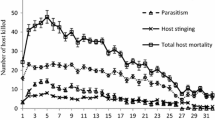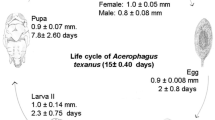Abstract
The biology ofEpidinocarsis (=Apoanagyrus) lopezi (DeSantis) was studied under fluctuating laboratory conditions of 24–31°C and 79–90% R.H. It is a solitary internal parasite. There are 4 tailed larval instars. The total developmental time from egg to adult ranged from 11–25 days, average 18 days. The duration of each developmental stage was: egg 2 days, 1 st instar 1 day, 2nd instar 1 day, 3rd instar 2 days, 4th instar 2 days, prepupa 4 days and pupa 6 days. Males mated several times, females mated once. Mated females produced both males and females, unmated females produced only males. Mated ovipositing females lived for 13 days while non-ovipositing mated females lived for 25 days. Parasitization decreased with increasing host density from 30% at a density of 10 hosts/plant/female to 11% at a density of 50. There was virtually no pre-oviposition period. Based on 10 females, the highest mean daily progeny production was 10. Females have an average oviposition period of 11 days and an average of 67 adult progeny. The sex-ratio was 1∶2.3 in favour of females.
Résumé
La biologie deEpidinocarsis (Apoanagyrus) lopezi DeSantis a été étudiée en laboratoire sous des conditions de température et d'humidité relative allant de 24 à 31°C et de 79 à 90% respectivement. C'est un parasite solitaire interne. Il a 4 stades larvaires. La durée totale du développement de l'œuf à l'adulte va de 11 à 25 jours, moyenne 18 jours. La durée de développement de chaque stade était: œuf 2 jours, premier stade 1 jour, deuxième 1 jour, troisième 2 jours, quatriéme 2 jours, prèpupe 4 jours et pupe 6 jours. Les ♂ se sont accouplés plusieurs fois, les ♀ une seule fois. Les ♀ accouplées ont donné naissance aux 2 sexes, tandis que les non accouplées ont produit seulement des ♂. Les ♀ accouplées et pondeuses ont vécu pendant 13 jours, pendant que celles qui étaient accouplées, mais non-pondeuses, ont vécu pendant 25 jours. Le parasitisme a diminué avec la densité croissante de l'hôte allant de 30% à une densité de l'hôte de 10/plante/♀ à 11 % à une densité de l'hôte de 50. Il n'y avait pas apparemment de période de préoviposition. La plus forte production journalière de descendants, basée sur 10 ♀, a été de 10. La période moyenne d'oviposition était de 11 jours et la moyenne de descendance adulte était de 67. Le rapport de sexe était de 1∶2,3 en faveur des ♀.
Similar content being viewed by others
References
Clausen, C. P. — 1940. Entomophagous Insects. —McGraw-Hill, New York, 687 pp.
DeSantis, L. — 1963. Encirtidos de la Republica Argentina [Hymenoptera: Chalcidoidea]. — Volume IV. La Plata. 73–77.
Dyar, H. G. — 1890. The number of moults of Lepidopterous larvae. —Psyche, 5, 420–422.
Fabres, G. — 1981. Dynamics of Cassava mealybug populations in the people's republic of Congo. —Proc. 1st triennal Root Crops Symp. Int. Soc. trop. Root Crops. Africa Branch. Sept. 8–12, 1980. pp 90–93.
IITA — 1984. International Institute of Tropical Agriculture, Research Highlights for 1983. — Ibadan, Nigeria.
Lema, K. M. & Herren, H. R. — 1985. The influence of constant temperature on population growth rates of the cassava mealybug,Phenacoccus manihoti Mat. Ferr. [Homoptera: Pseudococcidae]. —Entomol. Exp. Appl. (In Press).
Nenon, J. P., Fabres, G. & Biassan Gama, A. — 1985.Epidinocarsis lopezi [Hym.: Encyrtidae] parasitoïde introduit au Congo pour la régulation des populations de la Cochenille du manioc.Phenacoccus manihoti [Hom.: Pseudococcidae]. — Résumés des communications présentées auVIIe Symp. Soc. Int. pour les Plantes à Tubercule Tropicales. — Guadeloupe: 1–6 juil 1985. p. 74.
Nwanze, K. F. — 1978. The biology of cassava mealybugPhenacoccus manihoti, Mat-Ferr. [Homoptera: Pseudococcidae] in the Republic of Zaire. In:Nwanze, K. F. & Leuschner, K., eds.,Proc. Int. Workshop. Inera-Mvuazi, Zaire, 22–29 June, 1977, p. 20–28.
Author information
Authors and Affiliations
Rights and permissions
About this article
Cite this article
Odebiyi, J.A., Bokonon-Ganta, A.H. Biology ofEpidinocarsis [=Apoanagyrus] lopezi [Hymenoptera: Encyrtidae] an exotic parasite of cassava mealybug,Phenacoccus manihoti [Homoptera: Pseudococcidae] in Nigeria. Entomophaga 31, 251–260 (1986). https://doi.org/10.1007/BF02373334
Received:
Accepted:
Issue Date:
DOI: https://doi.org/10.1007/BF02373334




